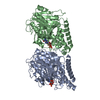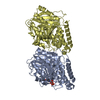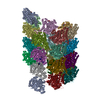+ Open data
Open data
- Basic information
Basic information
| Entry |  | |||||||||
|---|---|---|---|---|---|---|---|---|---|---|
| Title | Sub-tomogram average of Asgard AtubA/B microtubule | |||||||||
 Map data Map data | ||||||||||
 Sample Sample |
| |||||||||
 Keywords Keywords | Asgard archaea / microtubule / cryoEM / cytomotive filaments / cytoskeleton / STRUCTURAL PROTEIN | |||||||||
| Biological species |  Candidatus Lokiarchaeum ossiferum (archaea) Candidatus Lokiarchaeum ossiferum (archaea) | |||||||||
| Method | subtomogram averaging / cryo EM / Resolution: 18.0 Å | |||||||||
 Authors Authors | Wollweber F / Xu J / Ponce-Toledo RI / Rodrigues-Oliveira T / Malit JJL / Kokhanovska A / Wieczorek M / Schleper C / Pilhofer M | |||||||||
| Funding support | European Union, 1 items
| |||||||||
 Citation Citation |  Journal: Cell / Year: 2025 Journal: Cell / Year: 2025Title: Microtubules in Asgard archaea. Authors: Florian Wollweber / Jingwei Xu / Rafael I Ponce-Toledo / Florina Marxer / Thiago Rodrigues-Oliveira / Anja Pössnecker / Zhen-Hao Luo / Jessie James Limlingan Malit / Anastasiia Kokhanovska ...Authors: Florian Wollweber / Jingwei Xu / Rafael I Ponce-Toledo / Florina Marxer / Thiago Rodrigues-Oliveira / Anja Pössnecker / Zhen-Hao Luo / Jessie James Limlingan Malit / Anastasiia Kokhanovska / Michal Wieczorek / Christa Schleper / Martin Pilhofer /   Abstract: Microtubules are a hallmark of eukaryotes. Archaeal and bacterial homologs of tubulins typically form homopolymers and non-tubular superstructures. The origin of heterodimeric tubulins assembling ...Microtubules are a hallmark of eukaryotes. Archaeal and bacterial homologs of tubulins typically form homopolymers and non-tubular superstructures. The origin of heterodimeric tubulins assembling into microtubules remains unclear. Here, we report the discovery of microtubule-forming tubulins in Asgard archaea, the closest known relatives of eukaryotes. These Asgard tubulins (AtubA/B) are closely related to eukaryotic α/β-tubulins and the enigmatic bacterial tubulins BtubA/B. Proteomics of Candidatus Lokiarchaeum ossiferum showed that AtubA/B were highly expressed. Cryoelectron microscopy structures demonstrate that AtubA/B form eukaryote-like heterodimers, which assembled into 5-protofilament bona fide microtubules in vitro. The additional paralog AtubB2 lacks a nucleotide-binding site and competitively displaced AtubB. These AtubA/B2 heterodimers polymerized into 7-protofilament non-canonical microtubules. In a sub-population of Ca. Lokiarchaeum ossiferum cells, cryo-tomography revealed tubular structures, while expansion microscopy identified AtubA/B cytoskeletal assemblies. Our findings suggest a pre-eukaryotic origin of microtubules and provide a framework for understanding the fundamental principles of microtubule assembly. | |||||||||
| History |
|
- Structure visualization
Structure visualization
| Supplemental images |
|---|
- Downloads & links
Downloads & links
-EMDB archive
| Map data |  emd_52469.map.gz emd_52469.map.gz | 135.4 KB |  EMDB map data format EMDB map data format | |
|---|---|---|---|---|
| Header (meta data) |  emd-52469-v30.xml emd-52469-v30.xml emd-52469.xml emd-52469.xml | 12.5 KB 12.5 KB | Display Display |  EMDB header EMDB header |
| Images |  emd_52469.png emd_52469.png | 13.7 KB | ||
| Masks |  emd_52469_msk_1.map emd_52469_msk_1.map | 687 KB |  Mask map Mask map | |
| Filedesc metadata |  emd-52469.cif.gz emd-52469.cif.gz | 4.2 KB | ||
| Others |  emd_52469_half_map_1.map.gz emd_52469_half_map_1.map.gz emd_52469_half_map_2.map.gz emd_52469_half_map_2.map.gz | 502.7 KB 501.5 KB | ||
| Archive directory |  http://ftp.pdbj.org/pub/emdb/structures/EMD-52469 http://ftp.pdbj.org/pub/emdb/structures/EMD-52469 ftp://ftp.pdbj.org/pub/emdb/structures/EMD-52469 ftp://ftp.pdbj.org/pub/emdb/structures/EMD-52469 | HTTPS FTP |
-Validation report
| Summary document |  emd_52469_validation.pdf.gz emd_52469_validation.pdf.gz | 596.4 KB | Display |  EMDB validaton report EMDB validaton report |
|---|---|---|---|---|
| Full document |  emd_52469_full_validation.pdf.gz emd_52469_full_validation.pdf.gz | 596 KB | Display | |
| Data in XML |  emd_52469_validation.xml.gz emd_52469_validation.xml.gz | 6.2 KB | Display | |
| Data in CIF |  emd_52469_validation.cif.gz emd_52469_validation.cif.gz | 7.2 KB | Display | |
| Arichive directory |  https://ftp.pdbj.org/pub/emdb/validation_reports/EMD-52469 https://ftp.pdbj.org/pub/emdb/validation_reports/EMD-52469 ftp://ftp.pdbj.org/pub/emdb/validation_reports/EMD-52469 ftp://ftp.pdbj.org/pub/emdb/validation_reports/EMD-52469 | HTTPS FTP |
-Related structure data
- Links
Links
| EMDB pages |  EMDB (EBI/PDBe) / EMDB (EBI/PDBe) /  EMDataResource EMDataResource |
|---|
- Map
Map
| File |  Download / File: emd_52469.map.gz / Format: CCP4 / Size: 686.5 KB / Type: IMAGE STORED AS FLOATING POINT NUMBER (4 BYTES) Download / File: emd_52469.map.gz / Format: CCP4 / Size: 686.5 KB / Type: IMAGE STORED AS FLOATING POINT NUMBER (4 BYTES) | ||||||||||||||||||||||||||||||||||||
|---|---|---|---|---|---|---|---|---|---|---|---|---|---|---|---|---|---|---|---|---|---|---|---|---|---|---|---|---|---|---|---|---|---|---|---|---|---|
| Projections & slices | Image control
Images are generated by Spider. | ||||||||||||||||||||||||||||||||||||
| Voxel size | X=Y=Z: 8 Å | ||||||||||||||||||||||||||||||||||||
| Density |
| ||||||||||||||||||||||||||||||||||||
| Symmetry | Space group: 1 | ||||||||||||||||||||||||||||||||||||
| Details | EMDB XML:
|
-Supplemental data
-Mask #1
| File |  emd_52469_msk_1.map emd_52469_msk_1.map | ||||||||||||
|---|---|---|---|---|---|---|---|---|---|---|---|---|---|
| Projections & Slices |
| ||||||||||||
| Density Histograms |
-Half map: #1
| File | emd_52469_half_map_1.map | ||||||||||||
|---|---|---|---|---|---|---|---|---|---|---|---|---|---|
| Projections & Slices |
| ||||||||||||
| Density Histograms |
-Half map: #2
| File | emd_52469_half_map_2.map | ||||||||||||
|---|---|---|---|---|---|---|---|---|---|---|---|---|---|
| Projections & Slices |
| ||||||||||||
| Density Histograms |
- Sample components
Sample components
-Entire : microtubule structure of Asgard tubulins AtubA/B
| Entire | Name: microtubule structure of Asgard tubulins AtubA/B |
|---|---|
| Components |
|
-Supramolecule #1: microtubule structure of Asgard tubulins AtubA/B
| Supramolecule | Name: microtubule structure of Asgard tubulins AtubA/B / type: complex / ID: 1 / Parent: 0 / Macromolecule list: #1-#2 |
|---|---|
| Source (natural) | Organism:  Candidatus Lokiarchaeum ossiferum (archaea) Candidatus Lokiarchaeum ossiferum (archaea) |
-Experimental details
-Structure determination
| Method | cryo EM |
|---|---|
 Processing Processing | subtomogram averaging |
| Aggregation state | filament |
- Sample preparation
Sample preparation
| Buffer | pH: 6.8 |
|---|---|
| Vitrification | Cryogen name: ETHANE-PROPANE |
- Electron microscopy
Electron microscopy
| Microscope | TFS KRIOS |
|---|---|
| Image recording | Film or detector model: GATAN K3 (6k x 4k) / Average electron dose: 4.2 e/Å2 |
| Electron beam | Acceleration voltage: 300 kV / Electron source:  FIELD EMISSION GUN FIELD EMISSION GUN |
| Electron optics | Illumination mode: FLOOD BEAM / Imaging mode: BRIGHT FIELD / Nominal defocus max: 5.0 µm / Nominal defocus min: 3.0 µm |
| Experimental equipment |  Model: Titan Krios / Image courtesy: FEI Company |
- Image processing
Image processing
| Final reconstruction | Applied symmetry - Point group: C1 (asymmetric) / Resolution.type: BY AUTHOR / Resolution: 18.0 Å / Resolution method: FSC 0.143 CUT-OFF / Number subtomograms used: 2363 |
|---|---|
| Extraction | Number tomograms: 36 / Number images used: 4264 |
| CTF correction | Type: NONE |
| Final angle assignment | Type: MAXIMUM LIKELIHOOD |
 Movie
Movie Controller
Controller



















 Z (Sec.)
Z (Sec.) Y (Row.)
Y (Row.) X (Col.)
X (Col.)












































